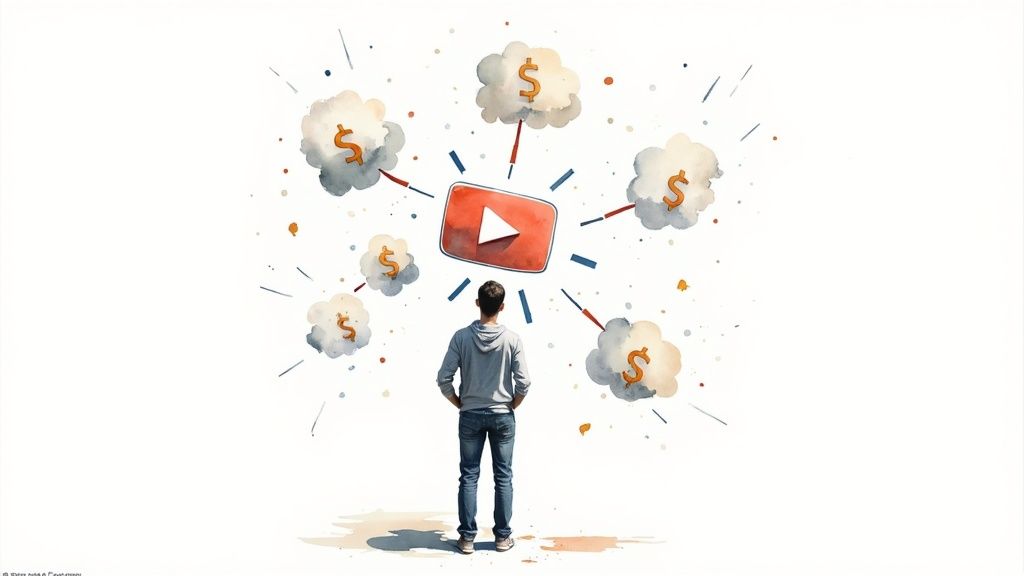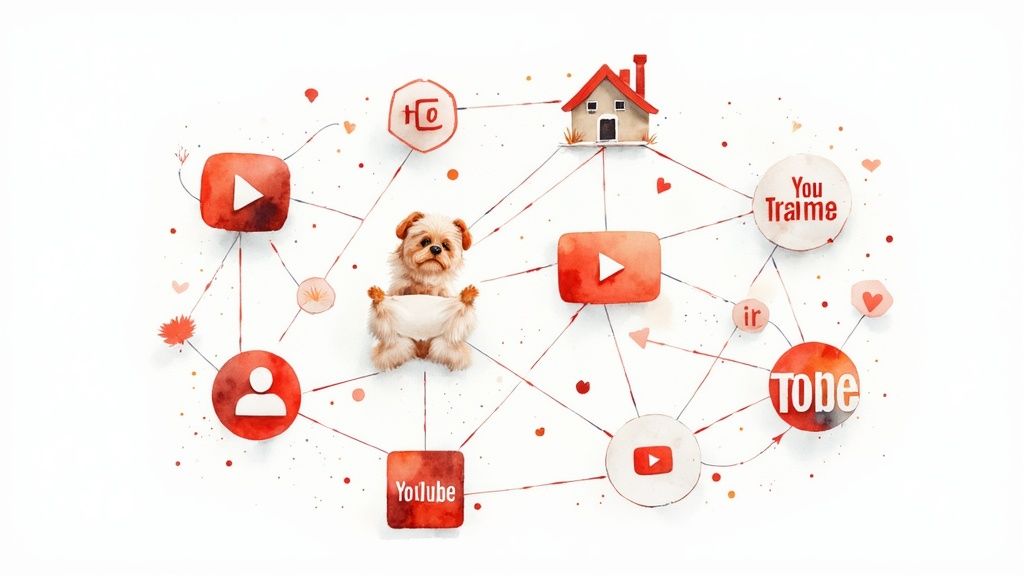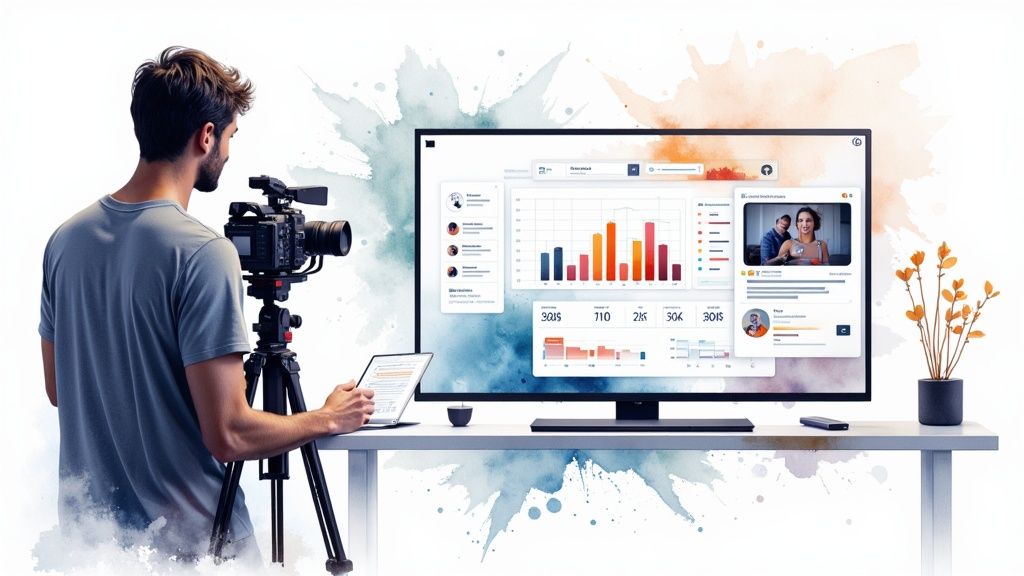In This Article
Subscribe to our newsletter
The Evolving Video Monetization Landscape

The world of video content is constantly changing, offering exciting new ways to make money. Traditional methods like pre-roll ads aren't enough anymore. Smart creators are diversifying their income and adapting to how their audiences behave. This change is happening because of several reasons, including audience preferences, platform trends, and demographics. Understanding these factors is key to building a sustainable business.
Shifting Audience Preferences
Viewers want authentic and engaging content. They don't like intrusive ads and respond better to creators who offer real value. This has led to new ways of making money, like fan funding, subscriptions, and merchandise. Patreon allows creators to connect directly with their audience and earn recurring revenue. Interactive content like live streams and Q&As offers more ways to earn through features like Super Chats and Super Thanks on YouTube.
Platform-Specific Trends
Each platform has its own advantages and disadvantages for making money from videos. YouTube is still a major player, but its algorithm and monetization policies are always changing, so creators need to keep up and adapt. Other platforms like Twitch and Facebook are gaining popularity, too. Knowing how each platform works, including audience demographics, is important for earning potential.
Let's look at the growth of video monetization. To understand the scale of this growth, check out the table below:
Video Monetization Growth Metrics
| Metric | Value | Year-over-Year Change |
|---|---|---|
| Global Digital Video Ad Spending (2024) | $191.4 billion | 10% |
| Projected Global Digital Video Ad Spending (2025) | $207.5 billion | |
| YouTube Monthly Active Users (2022) | 2.68 billion | |
| Average Cost of a YouTube Ad | $0.010 - $0.030 per view |
This table shows the impressive growth of video advertising revenue and the massive reach of platforms like YouTube. For more in-depth statistics, check out this resource: Find more detailed statistics here. These numbers highlight the importance of video in today's advertising strategies.
Demographic Changes
Knowing your audience is vital. Different demographics have different preferences and spending habits. Younger audiences might like in-app purchases, while older audiences might prefer subscriptions. Location also affects ad revenue. By analyzing audience data, creators can tailor content and strategies to connect with specific demographics and maximize earnings. This allows for better content decisions, increased viewer engagement, and greater monetization success.
Platform-Specific Tactics That Actually Drive Revenue

Monetizing video content effectively requires understanding each platform's nuances. This means tailoring your approach to each platform's audience while using the right monetization tools. A polished, long-form video might do well on YouTube, while short, engaging clips might be better on TikTok.
Let's explore some platform-specific tactics that truly drive revenue.
YouTube: The Partner Program and More
YouTube remains a powerhouse for video monetization, largely thanks to its Partner Program. The program offers multiple revenue streams, including ad revenue sharing, channel memberships, and Super Chat during live streams.
Success on YouTube means understanding its algorithm and policies. Focusing on high-quality content, consistent uploads, and audience engagement is key. These factors help grow your subscriber base and watch time, boosting your earning potential.
Facebook: Community and In-Stream Ads
Facebook's strength lies in its community-building features. Creators can monetize through in-stream ads, fan subscriptions, and even sales via Facebook Shops.
Building a loyal following is crucial for driving engagement and revenue. This engaged audience opens doors for sponsorships and branded content, diversifying income. Using Facebook's analytics helps understand viewer behavior and optimize content.
Twitch: Engaging the Live Stream Audience
Twitch is all about live streaming, making audience interaction essential. Monetization options include subscriptions, donations (bits), and sponsorships.
Building a dedicated community is key. This involves cultivating a strong personality, consistent streaming, and exclusive content for subscribers. Understanding gaming culture and catering to niches can significantly impact your revenue.
Instagram and TikTok: Short-Form Content and Influencer Marketing
Instagram and TikTok thrive on short-form video, making them perfect for influencer marketing. Creators can monetize through brand partnerships, sponsored content, and selling merchandise or services.
Creating engaging visuals that align with trending hashtags and challenges is essential for reaching a wider audience. Instagram Shopping also offers a seamless way to monetize product-focused videos.
Monetizing on Your Own Website: Control and Revenue
Hosting videos on your own website gives you full control over monetization. You can integrate ads, offer paid memberships, and sell videos directly. This often leads to higher per-viewer revenue compared to third-party platforms.
However, running a website requires technical skills and marketing to attract and retain an audience. You might be interested in: How to master video ad products.
To help illustrate the revenue potential across different platforms, let's take a look at the following comparison:
Platform Revenue Comparison: Side-by-side analysis of monetization options across major video platforms
| Platform | Revenue Options | Audience Reach | Entry Requirements | Avg. Creator Earnings |
|---|---|---|---|---|
| YouTube | Ads, Partner Program, Memberships, Super Chat, Merchandise | Massive, Global | 1,000 subscribers, 4,000 valid watch hours | Varies widely; highly dependent on views, engagement, and niche |
| In-stream ads, Fan Subscriptions, Facebook Shops | Large, Global | Varies depending on monetization method | Varies, typically lower than YouTube | |
| Twitch | Subscriptions, Donations (Bits), Sponsorships | Niche, Gaming Focused | Affiliate or Partner status | Highly variable, dependent on community size and engagement |
| Brand Partnerships, Sponsored Content, Shopping Features, Affiliate Marketing | Large, Visual Focus | Growth focused; high engagement and follower count advantageous | Highly variable, dependent on niche and brand deals | |
| TikTok | Brand Partnerships, Creator Fund, Influencer Marketing, Live Gifting | Massive, Trend-Driven | Growth focused; high engagement key | Highly variable, dependent on virality and brand collaborations |
| Self-Hosted Website | Ads, Memberships, Direct Sales | Dependent on marketing efforts | Website and hosting infrastructure | Potentially high, but requires significant investment and audience building |
As you can see, each platform presents its own unique opportunities and challenges. Choosing the best one depends on your specific content, target audience, and business goals.
Content creators have seen substantial revenue increases from video, especially in the U.S. In 2024, U.S. creators earned approximately $8.14 billion from sponsored content alone, up from $5.2 billion in 2021. Platform payouts generated about $3.23 billion in 2024. Explore this topic further. The rise of video platforms has empowered creators to use diverse monetization methods, including subscriptions and sponsorships.
Crafting Content That Attracts Viewers and Advertisers

Successfully monetizing video content involves a delicate balance: appealing to viewers while also attracting advertisers. It's a challenge, but this section explores how top creators manage this balancing act, enabling effective monetization strategies. The key lies in a robust content strategy, understanding your audience, and maintaining authenticity.
Building Content Pillars
Think of your video content like a building. A strong building needs solid pillars, and so does your content. These Content Pillars are core themes that provide a framework for consistent video creation. They ensure your videos resonate with your target audience.
For example, a cooking channel might establish pillars like "Quick Weeknight Meals," "Baking Basics," and "Global Cuisine." This structure not only attracts specific viewers but also helps attract sponsors relevant to those themes.
Sustainable Production
Regularly creating engaging videos requires a sustainable production schedule. Find a balance between quality and upload frequency. Consistency builds a loyal audience and creates predictable revenue.
It also makes your channel more attractive to potential sponsors. They appreciate knowing they can rely on a steady stream of content to reach their target demographic.
Identifying Resonant Themes
Understanding your audience is crucial for monetizing video content. Analyze viewer demographics, interests, and engagement patterns. This allows you to tailor content and attract valuable demographic segments.
Happy viewers engage with ads and support your channel through other monetization methods. This is particularly important given the growing effectiveness of video marketing. In 2023, 87% of online marketers used video content, with 51% citing it as having the best ROI. Learn more about video marketing statistics.
Testing and Authenticity
Experimenting with new formats is essential for growth, but it’s important to avoid alienating your core audience. Analyze your current video performance data and gradually introduce new formats to minimize risk.
Maintaining authenticity while optimizing for monetization is vital. Be transparent about sponsored content. Ensure any partnerships align with your brand values. You might be interested in how to create engaging video overlay text.
Optimizing Your Video Library
A diverse video library is key to reaching a broader audience and increasing monetization opportunities. Include a mix of evergreen content (timeless videos) and trending content (videos on current topics).
Evergreen content provides a stable foundation for long-term revenue. Trending content attracts new viewers and keeps your channel fresh. This diverse library also attracts sponsors looking to reach specific demographics. By strategically managing your video content, you maximize viewer engagement and monetization potential.
Building Multiple Revenue Streams From Your Video Content

Putting all your eggs in one basket is risky, especially when it comes to video content monetization. Smart creators understand the importance of diversifying their income. This section explores the numerous avenues available, from traditional ad revenue to selling merchandise, and how to strategically combine them for maximum impact. We'll also delve into the effort involved and potential earnings for each method.
Diversifying Your Income Portfolio
Think of your monetization strategy as an investment portfolio. Diversification is crucial for mitigating risk and optimizing returns. Just as you wouldn't invest all your money in a single stock, relying solely on one monetization method can be precarious.
For example, imagine your income primarily comes from ad revenue. If the platform's ad rates suddenly decline, your earnings take a significant hit. However, if you have other income sources, like sponsorships, memberships, or merchandise sales, you're better protected against such fluctuations. Diversification creates financial resilience.
Exploring Monetization Methods
Let's examine the core monetization methods and their potential:
- Advertising Revenue: Often the starting point for creators, especially on platforms like YouTube. Earnings depend on factors like views, engagement, and the platform's ad rates. For deeper insights into this ever-evolving landscape, check out this informative article: Video monetization in 2025.
- Sponsorships: Collaborating with brands to showcase their products or services in your videos can be highly profitable. The key is finding sponsors that align with your content and resonate with your audience.
- Affiliate Marketing: Promoting products through unique affiliate links earns you a commission on every sale. This method works best when promoting products relevant to your video content.
- Memberships and Fan Funding: Platforms like YouTube and Patreon offer membership and fan funding features, creating a recurring income stream from dedicated viewers. This fosters a stronger connection with your audience.
- Merchandise Sales: Selling branded merchandise, such as t-shirts, mugs, or stickers, is an excellent way to generate revenue and solidify your brand identity.
- Direct Sales and Courses: If you possess expertise in a specific field, creating and selling online courses or digital products related to your videos can be a lucrative avenue.
- Licensed Content: Licensing your video content for use by others, such as stock footage platforms or businesses for marketing purposes, can provide an additional revenue stream.
Layering Monetization Strategies
Building multiple revenue streams isn't about using every method available. It's about strategically choosing methods that complement each other and resonate with your audience without feeling overwhelming.
Consider combining ad revenue with affiliate marketing for products featured in your videos. You could also offer exclusive content or behind-the-scenes access through a membership program. Strategic layering maximizes your earning potential.
Building a Monetization Roadmap
A clear roadmap is essential for long-term success. Begin by identifying your target audience and understanding their preferences. Then, analyze which monetization methods align best with your content and audience.
Don't hesitate to experiment. Start with one or two methods and gradually incorporate others as your channel expands. Continuously analyze your results and adjust your strategy accordingly. A flexible approach ensures sustainable growth and income.
Smart Production Investments That Boost Monetization
Investing in higher production quality can significantly impact your video content's monetization potential. However, it's crucial to be strategic about where you allocate resources. Not all upgrades offer the same return on investment. This section explores how successful creators prioritize their production investments for maximum impact.
Cost-Effective Equipment and Software Upgrades
While professional-grade equipment is appealing, it's not always essential, especially when starting. Prioritize upgrades that offer the biggest improvements for your content.
Audio Quality: Crisp, clear audio is crucial. Investing in a good microphone significantly enhances viewer experience and professionalism.
Lighting: Effective lighting dramatically improves video quality, making your content more visually engaging for viewers and potential sponsors.
Editing Software: Intuitive editing software like Adobe Premiere Pro lets you create polished, captivating videos that hold viewer attention.
These upgrades often have a greater impact than, for example, an expensive camera, especially in the early stages of your channel's development.
Building a Sustainable Production Model
As your channel grows, so will your production needs. Develop a scalable production model. This includes creating efficient workflows and potentially outsourcing some tasks.
You might begin by handling all production aspects yourself. As your channel expands, consider outsourcing tasks like editing or graphic design. This frees up your time to focus on content creation.
Yandex, a prominent Russian technology company, understands the power of video. Between 2021 and 2023, they invested roughly 73 billion rubles in video content production and acquisition. They've earmarked another 100 billion rubles for media services in 2024-2025, focusing on local content. This significant investment underscores the growing demand for online media consumption. You can find more detailed statistics here.
Outsourcing vs. In-House Capabilities
Deciding whether to outsource or build in-house capabilities hinges on your budget, resources, and long-term goals. Outsourcing offers flexibility and access to specialized skills. Building an in-house team provides greater control and consistency.
Consider outsourcing tasks requiring specialized skills, such as animation or motion graphics. For core tasks like filming and editing, an in-house team might be more beneficial over time. For a broader revenue approach, consider strategies for monetizing social media.
Production Quality and Revenue Streams
Production quality's impact varies across different revenue streams and content categories. High production quality can attract more viewers and higher-paying advertisers for ad-supported content.
For sponsored content, production quality is essential. Brands want their products and services presented in the best light. High production value also builds trust and credibility for direct sales, like online courses, making viewers more likely to purchase. Strategic investment in production enhances viewer experience, attracts valuable sponsors, and maximizes your monetization potential across various revenue streams.
Using Data to Maximize Your Video Revenue
Beyond simple view counts, a treasure trove of data can significantly boost your video revenue. This section explores how successful creators use analytics to make informed decisions, focusing on the metrics that truly drive financial success. This means understanding which numbers correlate with monetization performance, building efficient tracking systems, and using A/B testing to optimize your strategies.
Identifying Key Metrics (Beyond Vanity Metrics)
While vanity metrics like view counts and subscriber numbers can feel good, they don't always directly lead to higher earnings. Instead, prioritize these key performance indicators (KPIs):
Watch Time: This shows how long viewers are engaged with your content. Higher watch time often means higher ad revenue and suggests your content resonates.
Audience Retention: This measures the percentage of a video that viewers watch. High retention signifies compelling content, potentially boosting ad impressions and viewer loyalty.
Click-Through Rate (CTR): For videos with calls to action, such as affiliate links or merchandise, CTR measures how often viewers click. A higher CTR indicates effective promotion and can significantly impact revenue.
Conversion Rate: This metric tracks viewers who complete a desired action, like making a purchase or joining a membership. It directly reflects the effectiveness of your monetization strategy.
By focusing on these actionable metrics, you'll gain a clearer understanding of what actually drives revenue.
Building a Simple Tracking System
A simple tracking system helps you monitor these key metrics and spot trends. Begin with a spreadsheet or utilize the analytics dashboards provided by platforms like YouTube. Track metrics like watch time, audience retention, and CTR for each video. Look for patterns. Which video topics or formats perform best? When do you see the highest engagement? This data lets you refine your content strategy and optimize for monetization.
A/B Testing Monetization Strategies
A/B testing is a powerful tool for optimizing your monetization. It involves comparing two versions of something to see which performs better. Experiment with different ad placements or test various calls to action for affiliate links. You could also A/B test different pricing models for memberships or try various promotional strategies for merchandise. Analyzing the results helps identify the most effective strategies without alienating your audience.
Interpreting Audience Data
Analyzing audience demographics, viewing habits, and engagement patterns helps you better understand your viewers. This data offers insights into what content resonates, allowing you to tailor your video production. It also helps you identify potential sponsors or brand partnerships that align with your audience’s interests. If your audience is primarily interested in gaming, partnering with gaming accessory brands or game developers might be a good strategy.
Making Informed Decisions
Data-driven insights empower strategic decisions about your video content and monetization. Use this data to:
Refine content direction: Create more videos on topics that perform well based on watch time, retention, and revenue.
Optimize platform focus: Concentrate your efforts on platforms where you see the highest return on investment.
Adjust your revenue model: Diversify income streams based on audience preferences and platform opportunities. If you see high engagement on live streams, consider features like Super Chats or exclusive memberships.
By consistently analyzing data and adapting based on your findings, you can continuously optimize your video content and maximize your revenue potential. Aeon, a video creation platform for publishers, empowers you to produce high-quality videos efficiently. Learn more about how Aeon can help you grow your video revenue: https://www.project-aeon.com.







.jpg)